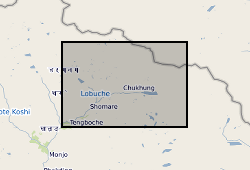Glacial geology
Type of resources
Topics
Keywords
Contact for the resource
Provided by
Years
Formats
Representation types
Update frequencies
-

These data consist of a spreadsheet containing 557 ground control points (GCPs) collected in the Everest region of Nepal between October 2015 and October 2016. GCPs were collected using a Leica GS10 differential Global Positioning System (dGPS), post-processed against base station data at Syangboche. These final data have sub-centimetre accuracy (in x, y and z) in all cases. Point positions are heavily concentrated around meltwater ponds on the glacier surface, and prominent features around the glacier margin. These data will be used by PhD students and staff in the School of Geography, University of Leeds, to provide ground control for fine-resolution satellite imagery and Structure-from-Motion surveys to assess mass loss processes on Khumbu Glacier.
-
This dataset consists of measurements of cosmogenic 10Be in quartz from a set of erratic cobbles collected from the surfaces of nunataks in West Antarctica. The cobbles were collected during the 2019-20 Antarctic field season from the Hudson Mountains, which are situated adjacent to Pine Island Glacier. The dataset includes cosmogenic nuclide (10Be) exposure ages and all field (sample locations and elevations) and analytical laboratory (quartz and beryllium carrier masses, Be-10/Be-9 ratios) data for field samples and procedural blanks required to calculate the ages. Natural Environment Research Council (NERC: Grants NE/S006710/1, NE/S006753/1, and NE/S00663X/1) and National Science Foundation (NSF: Grant OPP 2317097). Australian Nuclear Science and Technology Organisation (ANSTO) Centre for Accelerator Science award AP12872, through the National Collaborative Research Infrastructure Strategy (NCRIS).
-
This dataset consists of measurements of cosmogenic Be-10 and Al-26 in quartz for a set of cobbles collected from a moraine proximal to Mount Murphy, a nunatak located between Pope and Thwaites glaciers, West Antarctica. The cobbles were collected during the 2015-2016 Antarctic field season. The dataset includes cosmogenic nuclide (Be-10 and Al-26) surface exposure ages and all field (location, elevation, shielding, thickness) and analytical laboratory (quartz, beryllium and aluminium carrier masses, Be-10/Be-9 and Al-26/Al-27 ratios) data for field samples and procedural blanks required to calculate the ages. Funding source: Natural Environment Research Council (NERC: Grants NE/S006710/1 (JSJ), NE/K012088/1 (JSJ), NE/S006753/1 (DHR), NE/K011278/1 (DHR)). Australian Nuclear Science and Technology Organisation (ANSTO) Centre for Accelerator Science award AP12872 (DHR) through the National Collaborative Research Infrastructure Strategy (NCRIS).
-

The UK Geoenergy Observatories (UKGEOS) Glasgow superficial deposits GSI3D model outputs, created by the British Geological Survey, provide a semi-regional overview of the depth, thickness and extent of glacial and post-glacial lithostratigraphic units above rockhead. The model allows users to visualise the likely subsurface sequence to be found beneath this part of Glasgow, applicable at a scale of around 1: 25,000 to 1: 10,000. The data is supplied as grids and shapefiles over a 7 by 4.15 km area, with the depth range to around 40 m below Ordnance Datum. This model describes an interpretation of the shallow geology updated to incorporate the results of drilling the 12 UKGEOS Glasgow boreholes (post-drill model). Further details and model limitations can be found in the accompanying metadata report http://nora.nerc.ac.uk/id/eprint/531155/ . DOI: https://doi.org/10.5285/915f690f-32cf-41b7-984e-c32344d3a543
 NERC Data Catalogue Service
NERC Data Catalogue Service